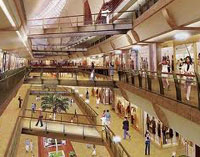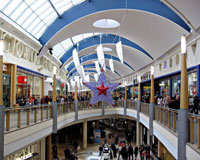
Last year was the best since 2005 for shopping centre investment, with nearly £5.5bn being transacted. But could 2015 top that?
For some the answer is a resounding ‘no’.
“It isn’t going to be quite as bumper a year,” says BNP Paribas’s Stuart Cunliffe. “This year we’ll see the same number of deals, but smaller deals. Say 25% less than last year. After all, there were some very large assets traded last year.”
One notable deal was Land Securities buying a 30% stake in Bluewater, Kent, for £656m in June.
Others disagree.
“I think it is going to be the same if not a bit more,” says John Griffin at Lunson Mitchenall. He argues that some big lot sizes will also be coming to the market in the second half of the year – “around the £500m-£1bn mark”.
The reason for these differing assessments is that the first half was certainly not a record breaker. “In the first half of 2015 the investment volumes were significantly below c.50% when compared to the corresponding period of 2014,” says Harry Wills, investment director at Bruce Gillingham Pollard.
According to Savills, 32 deals were transacted accounting for £1.9bn in the year to August. This is down 46% on the same period in 2014 when 47 deals brought in £4.4bn.
This was in part due to the uncertainty that surrounded the UK general election. Following the return of a Conservative government a slew of larger lots are now on the market, including Grand Central in Birmingham, QIC’s stake in Merry Hill, Dudley, and The Church Commissioners’ stake in Metrocentre, Gateshead, which it now deems to be too big for its portfolio.
“Those that have prime assets to sell will get bumper prices. There is no lessening of demand.”
While the first half of 2015 was quiet compared with 2014, the second half will have to be one for the record books to make up the ground.
Savills is confident that this will happen. It predicts the investment volume for the year will smash 2014’s total and bring in £6.5bn.
“There are a number of significant disposals coming through such as Festival Place in Basingstoke and a stake in Merry Hill,” says Nick Hart, head of UK and European shopping centre investment at Savills.
“These will see transaction volumes rise to 2006 levels before the end of this year.”
According to Savills’ number crunching, there are 32 shopping centres currently under offer, worth in excess of £1.5bn, as well as 45 in the market, worth upwards of £2.4bn, and 16 being prepared for sale, thought to be worth a total of £600m.
Regardless of whether it will be better than last year or not, there is a consensus about one thing: prime will get pricier.
“Those that have prime assets to sell will get bumper prices,” says Cunliffe. “There is no lessening of demand.”
Cunliffe adds: “Will there be another Bluewater sale? If there were, the clues would be there already. To top last year you need somebody stepping in and saying ‘I’ve just bought £1bn of intu assets’.”
Who is buying?
The short answer to the question “who wants to buy?” is “everybody”.
“All of the investor groups continue to be active in the market,” says Harry Wills, investment director at Bruce Gillingham Pollard.
Having said that, the opportunity funds and private equity houses are now taking profits where they can, so their sales are significantly outstripping their purchases.
“And there remains significant UK fund interest in the market, and they remain strong buyers while selling product that does not fit fund strategies into a strong market,” Wills adds.
Everyone has their own way of raising capital. Last year’s deals were characterised by a lot of private equity players with opportunity fund money. That means their costs of capital are higher, which means they need higher returns.
This year, Pradera boss Neil Varnham states, the institutions are back in the game. So that means low cost of capital. “The interesting thing is that they are buying things that are not really institutional grade.”
Not only is there more money, there is also more competition.
“There are more players,” says John Griffin at Lunson Mitchenall. “We are seeing a few new names creeping in.”
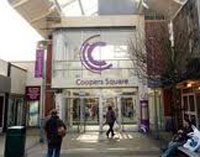
New Frontier, the Mauritian specialist which bought The Cleveland Centre in Middlesbrough and Coopers Square in Burton on Trent earlier this year, is one eager to buy more.
The Hark Group and InfraRed are also increasingly active and hungry. And then there is NewRiver.
But vendors can be suspicious of the new kid on the block until they have done their first deal, especially with shopping centres, which require a bit of expertise. “That’s why we bought off-market for New Frontier,” Griffin acknowledges.
The reason for this appetite is partly the attractiveness of the assets. But debt is also probably at its cheapest since the boom. The institutions are definitely back in play and the opportunity funds have more money than ever.
“The amount of money is huge and most of it will never find a home,” says Pradera’s Varnham.
“Our business plan models are really solid, but that doesn’t mean you’ll get it,” he adds. “Because you may be more cautious than the next lunatic.”
The competition is fierce.“I wouldn’t say it is a bloodbath out there, but it is certainly a competitive market,” says James Ryman, executive director at Capital & Regional. His team, since the company converted to a REIT in December, is now in the market for more town centre ‘community centres’.
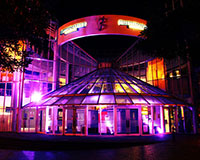
Last year it bought Buttermarket in Ipswich, its first acquisition in a decade. But the weight of capital, the low cost of lending and a lack of appropriate stock is making it hard to add to the portfolio.
“We haven’t bid too hard on too many things because we weren’t comfortable with what the story was. When the right scheme comes up that will influence how we bid,” says Ryman.
He puts the fact that others can afford higher bids down to how they raise their money. “The cost of capital is very attractive. The weight of the money is such that people can pay where these prices have gone, even if we won’t.”
Damn the season
Half a decade ago you could set your calendar, if not your watch, by when assets were released to market and when they were bought and sold.
The second half was always better than the first half, the summer was always dry to the point of being an arid wasteland and every agent worth the fee would try to get the deal done before anyone started singing Auld Lang Syne.
Not any more. It isn’t just the general election which has skewed the calendar for this year’s releases. It is the fact that the market is now international, and fiercely competitive.
“If you have a great asset which will get international attention then you can sell it at any time of the year,” says BNP Paribas’s Stuart Cunliffe. “If I am bringing out something of international grade then I don’t worry about when I bring it out. But domestic you still say, keep it until September.”
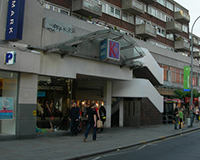
Yields
Average net initial yields have fallen from 8.02% to 7.21% year on year, reflecting increased demand and the popularity of the sector with investors.
Investors are also recognising the premium value of shopping centres in London, with extremely strong bidding as a result. In Q2 2015, the perceived rental growth and development potential at Kings Mall in Hammersmith, W6, led to some competitive bidding, which pushed the net initial yield to 4.25%.
Even tighter is Angel Central in Islington (formerly known as The N1 Centre), which is under offer at £34m over asking terms to clients of CBRE Global Investors. That reflects a net initial yield of just 3.9%.
What about the non-prime?
Prime keeps getting pricier, international money desperately wants international-grade assets and the value of the top 100 centres are set to soar.
According to new research by BNP Paribas that is not just hyperbole. It predicts that the gulf between the top 100 centres and ‘the rest’ will just keep growing as retailers fly to quality.
But what about the rest? “The demand is there,” says BNP Paribas’s Stuart Cunliffe, “but it is price driven.”
And the sheer weight of money is helping to push investors beyond their traditional comfort zones. “From a macro level there is more overseas money looking beyond London and the South East,” says John Griffin at Lunson Mitchenall.
But they are not looking at anything less than regionally dominant assets. Indeed, a number of centres on the market have still to find a buyer.
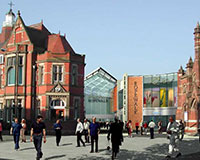
Nuneaton’s Ropewalk, which has always had to fight a strong out-of-town offer, has not sold. Rugby’s Clock Towers has not sold, and yet the yield on that and the price is rising. Friars Square in Aylesbury is being marketed at an 8% yield.
“Many remain on the market due to unrealistic pricing expectations, poor trade or geographical location and weak expiry profiles,” notes Savills’ Nick Hart. “Over the summer we expect yields will continue to harden for the very best product, but given the quantum of secondary stock available these assets will need to be priced very attractively to find a home.”
And that will happen, says Cunliffe. “Sales will only happen at the right price, so the yields are moving out.”
Others are less convinced that good sense will prevail.
“There are nominally 1,000 shopping centres in the country,” muses Pradera boss Neil Varnham. “Of those there are maybe 500 to 600 that I would be interested in. For the other 400, you would have to be [magician] David Blaine to make that work.”
Still, people end up buying them. One hallmark of the past 18 months has been investors buying up the lower ends because of the yields. Shopping centres were cheap, compared with 2007, and borrowing cheaper.
“Because of that you will always get someone who is very pleased to buy it for 9%,” says Varnham. “But, in reality, they shouldn’t have bought it for less than 15%, because all it is is a wasting, deteriorating asset.”
All you can do, he says, is run the slide rule, work out your strategy, and stick to your bid. “And then some crazy bidder comes in and pays a silly amount for it.”







